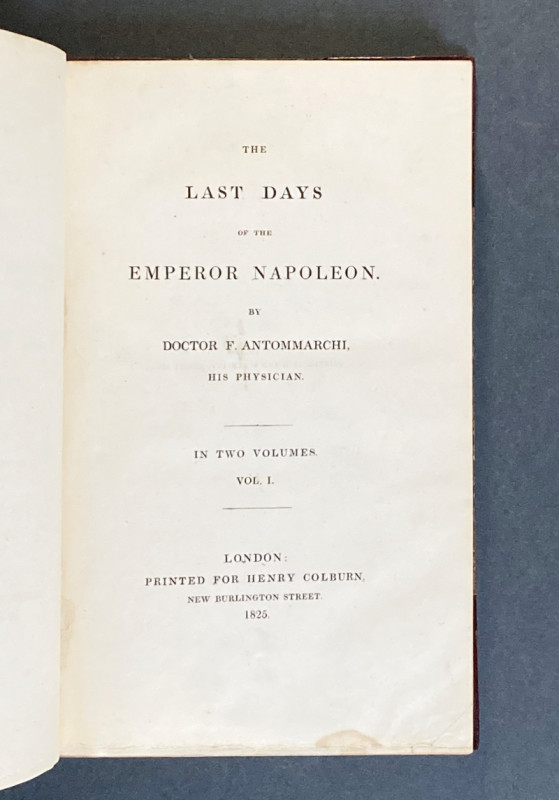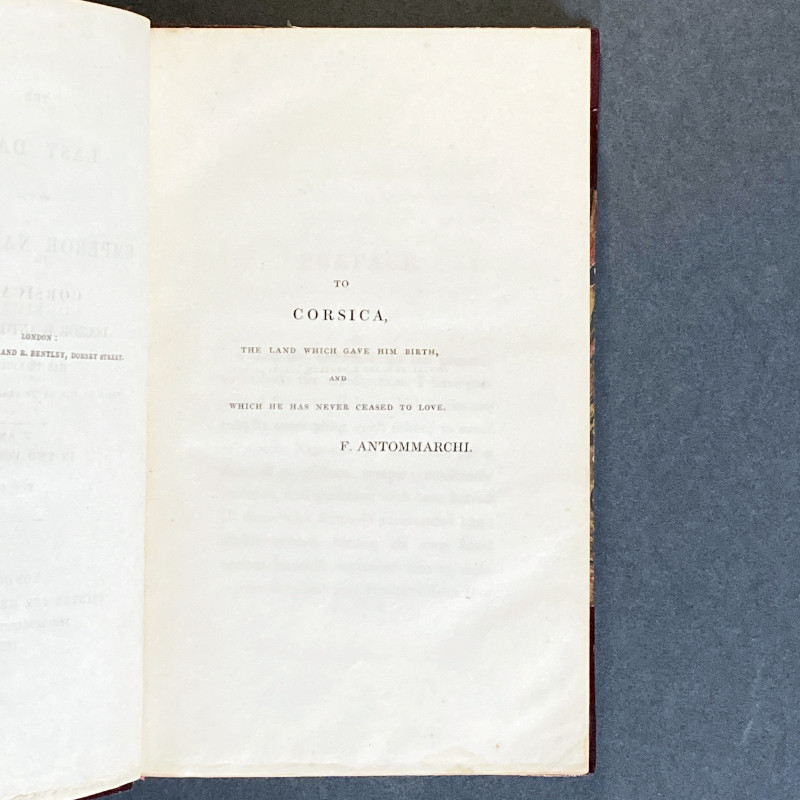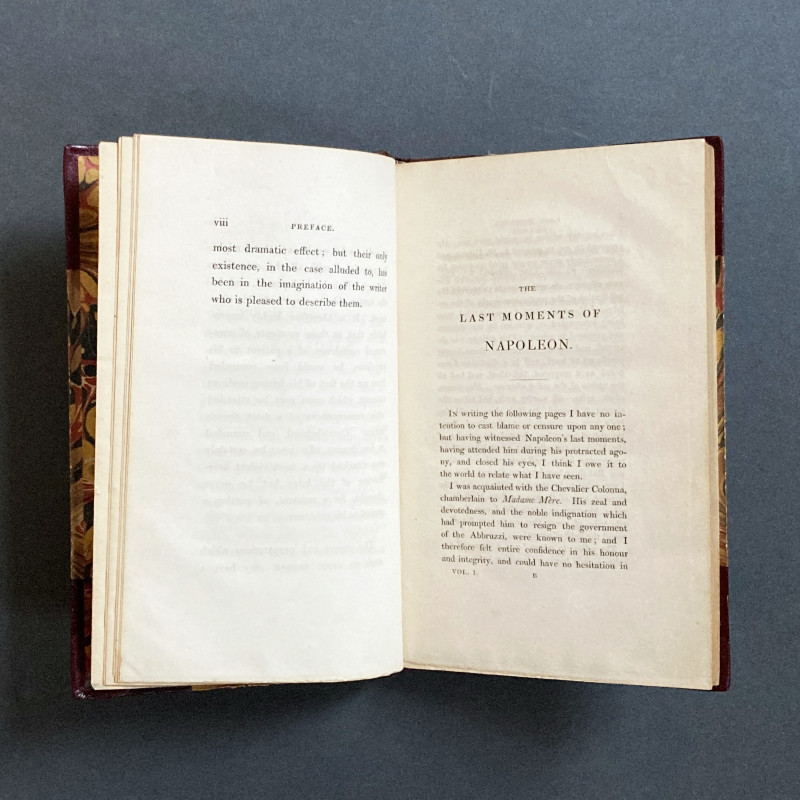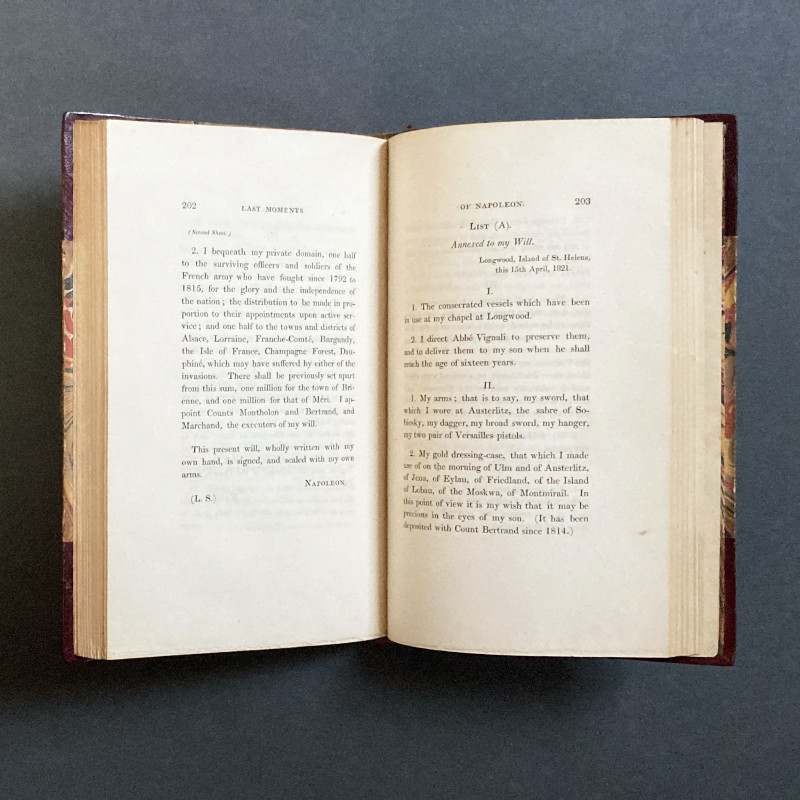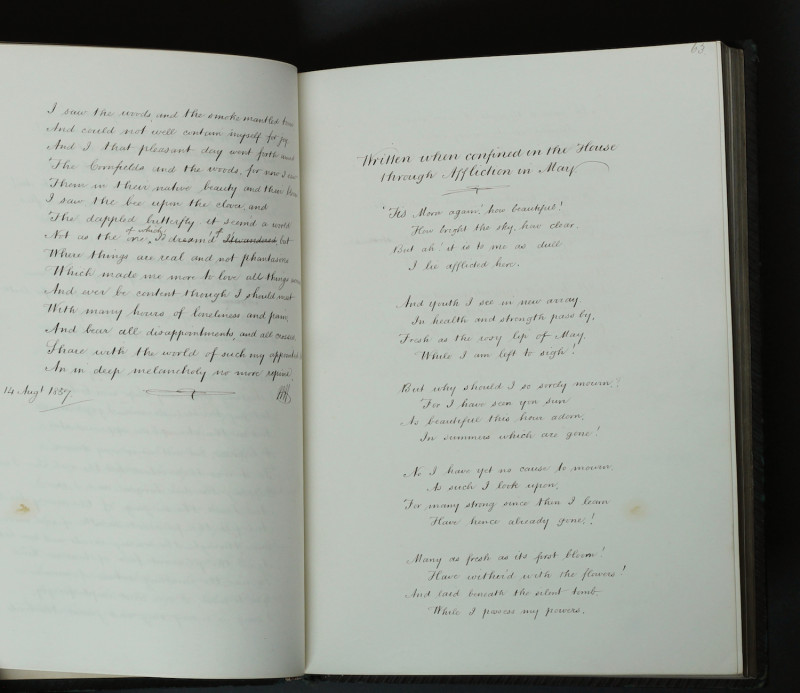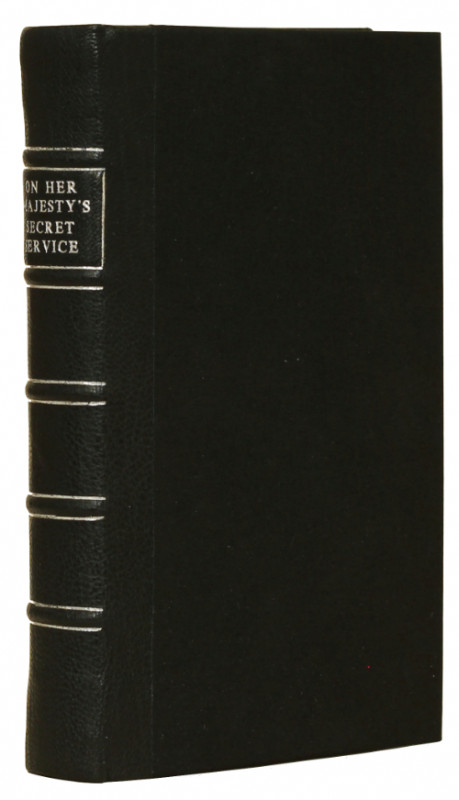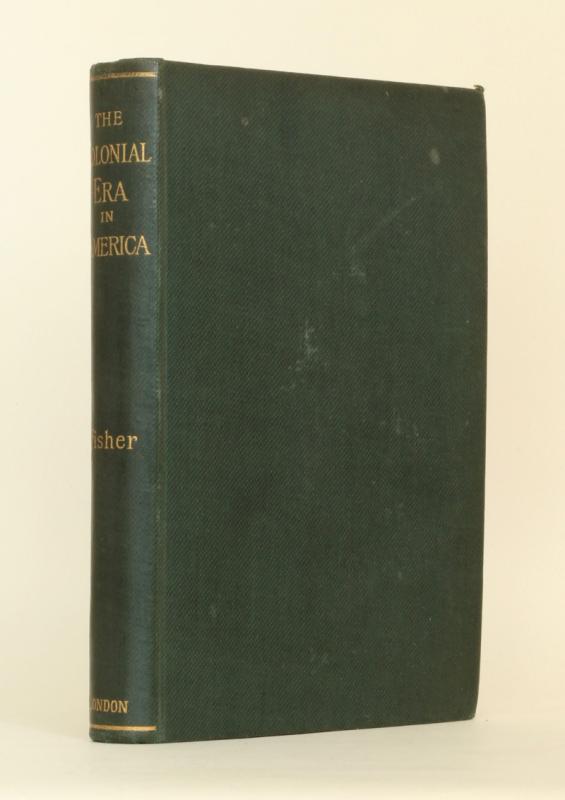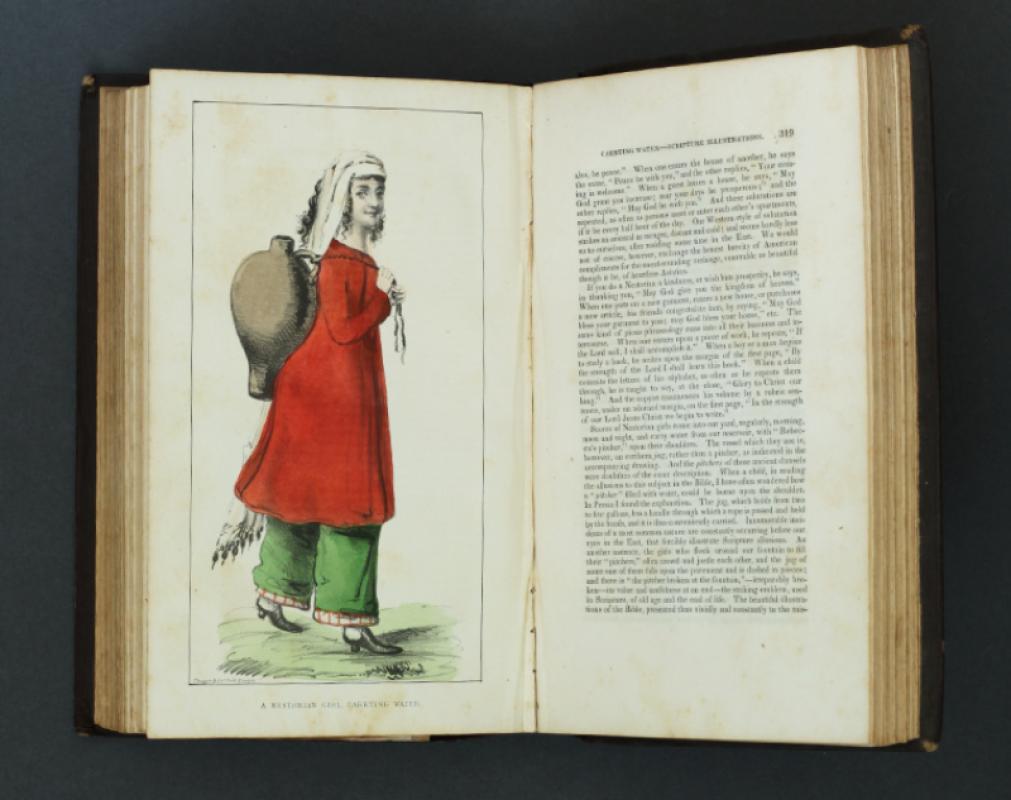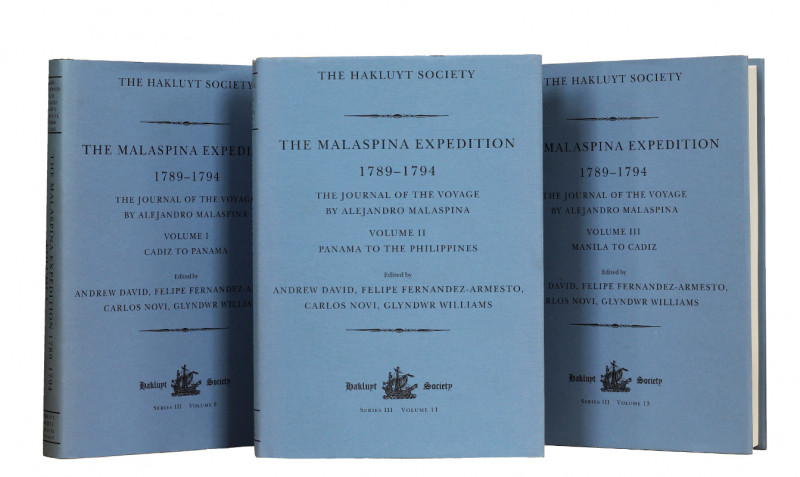The Last Days of the Emperor Napoleon






Book Description
FIRST ENGLISH EDITION OF ANTOMMARCHI’S IMPORTANT ACCOUNT OF NAPOLEON’S FINAL MONTHS ON ST HELENA
2 volumes, octavo (221 x 134mm), pp. I: viii (title, imprint, dedication, blank, preface), 416; II: [2 (title, verso blank)], 286. I, G6 with text on 3 lines partially or completely replaced with asterisks, and I, p. 287 and 319 misnumbered ‘278’ and ‘31 9’ respectively. (Some light spotting or marking, occasional candlewax or scorch marks, offsetting from markers, bound without vol. II half-title and final l. of advertisements.) 19th-century half hard-grained morocco over marbled boards, spine divided into compartments by raised bands, lettered directly in gilt in 2, marbled endpapers, top edges gilt, fore-edges cut, lower edges trimmed, red silk markers. (Some rubbing and scuffing causing small surface losses, some partial cracking on hinges.) A very good set.
2 volumes, octavo (221 x 134mm), pp. I: viii (title, imprint, dedication, blank, preface), 416; II: [2 (title, verso blank)], 286. I, G6 with text on 3 lines partially or completely replaced with asterisks, and I, p. 287 and 319 misnumbered ‘278’ and ‘31 9’ respectively. (Some light spotting or marking, occasional candlewax or scorch marks, offsetting from markers, bound without vol. II half-title and final l. of advertisements.) 19th-century half hard-grained morocco over marbled boards, spine divided into compartments by raised bands, lettered directly in gilt in 2, marbled endpapers, top edges gilt, fore-edges cut, lower edges trimmed, red silk markers. (Some rubbing and scuffing causing small surface losses, some partial cracking on hinges.) A very good set.
Dealer Notes
First English edition, probable later issue of volume I. Napoleon’s original physician on St Helena had been the Irishman Barry O’Meara, but O’Meara’s disagreements with Sir Hudson Lowe, the governor of the island, had led to the doctor’s dismissal in July 1818. Dr James Verling, the surgeon to the Royal Artillery on St Helena, was then appointed Napoleon’s physician, but Napoleon refused to see him, creating an impasse. Next, Napoleon’s mother and Cardinal Fesch selected the Corsican Francesco Antommarchi (1789-1838), a youthful but talented anatomist who had studied at Pisa and Florence under Mascagni and others, as Napoleon’s physician, and he arrived on St. Helena on 20 September 1819, making his first professional visit to his patient a few days later. Napoleon, who acknowledged Antommarchi’s expertise in anatomy, was not impressed by the physician’s limited knowledge of chemistry and thought him too young and inexperienced, commenting, ‘I would give him my horse to dissect, but I would not trust him with the cure of my own foot’ (A. Chaplin, A St. Helena Who’s Who (London, 1919), p. 49). In August 1819 comte de Montholon had asked the Scottish surgeon Archibald Arnott whether he would act as the emperor’s physician, but Arnott found the conditions too onerous and refused the role. Antommarchi continued to treat Napoleon until his death, although Arnott also attended him in the final months of his life. The day following Napoleon’s death on 5 May 1821, Arnott and Antommarchi performed a post mortem at Sir Hudson Lowe’s request, in the presence of other medical, military, and civic figures.
Antommarchi’s account of Napoleon’s final years was first published in French as Mémoires ou Des derniers momens de Napoléon (Paris, 1825), and then appeared in this English edition later in the same year (as did a German edition), to be followed by Italian and Spanish translations. Tulard notes that, although Antommarchi hoped that his account would enjoy a success comparable to that of Las Cases’s Mémorial de Sainte-Hélène (1823), ‘aussi son témoignage, comme la personne même d’Antommarchi ont-ils suscité bien des réserves’. In some copies of the first edition of volume I, leaf G6 is a cancellans and on p. 92 (the verso of G6) the words ‘The wretch thinks my agony too slow, he hastens its progress, my death is the object of all his wishes; he grudges even the air I breathe. Will you believe that his attempts against me have been open and continued,’ have been replaced with asterisks as well as some text on lines 15-17 of the page. In this copy of volume I, however, only the text of lines 15-17 on p. 92 have been replaced with asterisks, and the words quoted above are present (in this copy G6 appears to be conjugate with G3 and not a cancellans). The text present on p. 92 of this first volume also appears on p. 92 of the first volume of the second edition, which was published in 1826, suggesting that the present copy of volume I is a later issue of the first edition. The suppressed words apparently refer to Sir Hudson Lowe’s treatment of Napoleon, and were possibly redacted in earlier issues of the first edition for fear of legal action by Sir Hudson Lowe or the British government.
Kircheisen 4143; for the 1st ed., cf.: Davois I, p. 53; Horward XVI.11; Sandler 131; Tulard 14; Waller 17392a; Wellcome II, p. 49.
Antommarchi’s account of Napoleon’s final years was first published in French as Mémoires ou Des derniers momens de Napoléon (Paris, 1825), and then appeared in this English edition later in the same year (as did a German edition), to be followed by Italian and Spanish translations. Tulard notes that, although Antommarchi hoped that his account would enjoy a success comparable to that of Las Cases’s Mémorial de Sainte-Hélène (1823), ‘aussi son témoignage, comme la personne même d’Antommarchi ont-ils suscité bien des réserves’. In some copies of the first edition of volume I, leaf G6 is a cancellans and on p. 92 (the verso of G6) the words ‘The wretch thinks my agony too slow, he hastens its progress, my death is the object of all his wishes; he grudges even the air I breathe. Will you believe that his attempts against me have been open and continued,’ have been replaced with asterisks as well as some text on lines 15-17 of the page. In this copy of volume I, however, only the text of lines 15-17 on p. 92 have been replaced with asterisks, and the words quoted above are present (in this copy G6 appears to be conjugate with G3 and not a cancellans). The text present on p. 92 of this first volume also appears on p. 92 of the first volume of the second edition, which was published in 1826, suggesting that the present copy of volume I is a later issue of the first edition. The suppressed words apparently refer to Sir Hudson Lowe’s treatment of Napoleon, and were possibly redacted in earlier issues of the first edition for fear of legal action by Sir Hudson Lowe or the British government.
Kircheisen 4143; for the 1st ed., cf.: Davois I, p. 53; Horward XVI.11; Sandler 131; Tulard 14; Waller 17392a; Wellcome II, p. 49.
Author
ANTOMMARCHI, Francesco
Date
1825
Publisher
London: S. and R. Bentley for Henry Colburn
Friends of the PBFA
For £10 get free entry to our fairs, updates from the PBFA and more.
Please email info@pbfa.org for more information
